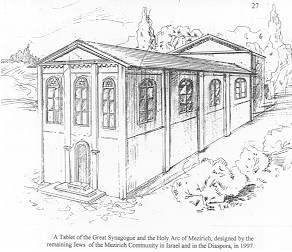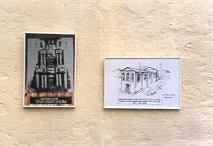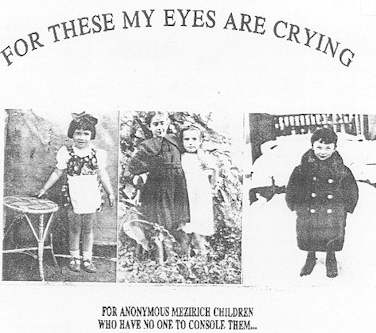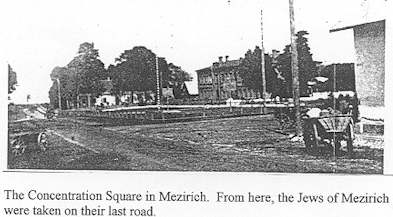Previous Page
|
Next Page
TRADITION IN OUR AREA
Weddings in our areas
When it was agreed by the sides in question that someone's daughter should be
given as a wife to someone's son, it was arranged to make the tie between them
as our forefathers had done before us, and so it was done:
First, the "Tnoim" contract of conditions. The celebration of the
meeting of the families for preparing the contract.
It was written how much dowry would be given, a partnership in a business or
businesses would be written, the means of support for the couple,
"kest" - maintaining a Yeshivah student, living quarters, clothing,
even the quality of the "Shtern tichell, (the head-covering of the wife,
worn for candle-lighting or for wearing the Synagogue) was included among the
jewelery written in the contract. Occasionally, it was stated in the contract
that the money, given as a dowry, should not be transferred as the dowry for
the groom's sister. All this was written in the contract by the registrar of
the contract, and the party was underway, usually with many townspeople
present, with kigel and kishke, fluden and shtrudel "cooked and
baked", each one as per his means and possibility. The ceremony was ended
by a hand-shake, a gift-giving, and the breaking of plates. (By the way, this
contract was taken very seriously, because of all these signs. There was a
saying "Instead of tearing the contract, better to write a
divorce.”). This is because the "Tnoim" contract held effects of
a vow (Jews were most wary of breaking a vow). Until this day, a Jew will not
promise anything without adding "without a vow". In the contract was
also set the wedding date.
The wedding in our area was held at the bride's home, or at the bride's
relatives' home, if the bride's parents' home was not suitable. The
celebrations began on Saturday, at the groom's home. This was the Saturday of
the groom's going up to the Torah (Ufrifen). The bride's family and friends
were invited to the Synagogue and showered the groom with candies. At the
Synagogue, “kiddush" was held for the entire congregation, and later
at the groom's home, a plentiful luncheon was served to the families of the
groom and bride, with singing which lasted till "Shaleshides" (the
third meal) just before sundown. "Ufrifen biz shaleshides" was
normal. At the "Ufrifen", cholnt was never served.
On Sunday began the foreshpiel (foreplay) - a week of events at the bride's
home. On Sunday - the bride's friends were invited to see the dowry trunk,
especially the embroidered bedding, the curtains, the tablecloths, the
underwear: embroidered slips, nightgowns, and the groom's gifts. The
refreshments were mostly delicate sweets (“petchenia" jam, and
inevitably
cooked millet porridge in milk with butter and honey floating on top. The main
thing was that everything be sweet. The girls sang, recited poetry in all
languages, listened to the gramophone, the married women offering advice to the
bride - as they were experienced. (I believe the American "bridal
shower" is a remnant of those Sundays.)
Monday was the day for the groom's friends. Everyone begins the day at the
Synagogue. Whoever did not get a chance to go up to the Torah on Saturday does
so. Again the refreshments are all sorts of herring fish and wine (cake and
cognac), bring up memories of bachelorhood, make speeches., if there are
learned men. If not
a speech is ordered. Chickpeas are eaten. Sometimes, they used to climb onto a
wagon or wagons and travel to the nearest forest or town. Then they returned
for the afternoon prayers, usually eat a full supper together, and then
accompany the groom home.
Tuesday is the poor man's day. Poor people from the entire region arrive. They
have their own source of information, especially if the bride's father is rich.
The poor people gather in the yard, or between two houses, where a tarpaulin is
put up, creating a tent. Tables and benches are brought from the Synagogue and
a full meal is served. I was once present at such an event. I will never forget
it. The bride's father hands out alms to the poor and they sing and dance till
evening.
On Wednesday, the aunts arrive. The seating at the tables is arranged. Nothing
is left to chance. The walking to the Chupah (canopy), the serving order, and,
of course, the aunts, too, inspect the dowry. Sometimes the bride distributes
her old wardrobe among poor relatives.
On Thursday, the out-of-town quests start arriving. The women in the family
accompany the bride to the "Mikveh" (public bathhouse) . The
"experts" enter the kitchen, sometimes also the kitchens of nearby
relatives, or to friendly neiqhbours. "Seven experts" is the norm.
Each place has its renowned experts - one is an expert for fish, one for
filled necks (geese necks filled with meat), one for kugel, one for fluden.
In our area, the "chuppah" (wedding ceremony) was always held on,
late Friday afternoon, near the Synagogue. The bride and groom fasted on their
wedding day. The ceremony begins with sitting the bride down on a chair. The
entertainer approaches the bride who is sitting on a white covered chair, in
her wedding dress, her eyes lowered and she's whispering prayers. (She still
does not know how much she must pray...)
Her mother is near her. A bride is never left alone. Satan is provoking. The
entertainer begins with "bride, bride, cry, cry,” and recounts all
the reasons for crying, and everyone cries: the bride's
mother, the grandmother, of course, and all the aunts. Afterwards, it is told
who cried and how much. The groom arrives and covers the bride's face. The
groom is accompanied by the fathers, the bride by the mothers. The bride's face
is covered. Everyone walks to the "Chupah" (canopy) at the Synagogue
- it doesn't matter what the distance - after them the entire public, all
holding lit candles. The musicians play, and the ceremony is held under the
open sky.
Everyone returns from the ceremony. The bride is received at the door of the
house with the “chala” (leavened bread) dance. A huge
“chala" is baked for this purpose. To receive the bride. The bride
lights the "Shabbat" candles for the first time with her mother and
other female relatives. Everyone is invited for supper - a holy Shabbat supper.
The groom's father makes the blessing over the wine ("Kiddush"). The
golden chicken soup is served (with oil floating on top), a king's feast. Seven
blessings, Torah recitations, proverbs, no music, of course. The young couple
is tired. The bride and groom have fasted and they must uphold the command of
unification.
The big celebration is held on Saturday night and, of course, each family as
per their means.
After the "Havdallah”, the public is invited to the
"wedding". The musicians play. Usually, one of the musicians is also
the announcer and he honours the guests by calling out their names. The dancing
begins. First to dance is the bride's mother with the bride, dancing the
“mitzvah dance". Then joins the groom's mother, the grandmother, the
aunts, and everyone. Mixed dancing (men and women together) is done while the
couple holds between them a handkerchief (so their hands won't touch). Each
town had its own special dances. So it was in our town.
Written by Dina Kurtz-Yanai, daughter of Gedalyahu and Sheindl Pressman from
Mezirich.
Previous Page
|
Next Page
This material is made available by JewishGen, Inc.
and the Yizkor Book Project for the purpose of
fulfilling our
mission of disseminating information about the Holocaust and
destroyed Jewish communities.
This material may not be copied,
sold or bartered without JewishGen, Inc.'s permission. Rights may be
reserved by the copyright holder.
JewishGen, Inc. makes no representations regarding the accuracy of
the translation. The reader may wish to refer to the original material
for verification.
JewishGen is not responsible for inaccuracies or omissions in the original work and cannot rewrite or edit the text to correct inaccuracies and/or omissions.
Our mission is to produce a translation of the original work and we cannot verify the accuracy of statements or alter facts cited.
 Mezirich, Ukraine
Mezirich, Ukraine
 Yizkor Book Project
Yizkor Book Project
 JewishGen Home Page
JewishGen Home Page
Yizkor Book Director, Lance Ackerfeld
This web page created by Lance Ackerfeld
Copyright © 1999-2025 by JewishGen, Inc.
Updated 6 July 2002 by LA








 Mezirich, Ukraine
Mezirich, Ukraine
 Yizkor Book Project
Yizkor Book Project
 JewishGen Home Page
JewishGen Home Page